It looks like you're using an Ad Blocker.
Please white-list or disable AboveTopSecret.com in your ad-blocking tool.
Thank you.
Some features of ATS will be disabled while you continue to use an ad-blocker.
Lost Technologies of the Pyramid Builders - Possible Evidence for Acoustic Engineering in Aswan
page: 3share:
a reply to: Marduk
Well, you know, since the actual tomb at the Djoser pyramid is under the pyramid, I'd say finding reliefs in the tunnels leading to the tomb is a pretty good indication of who the tomb was for... Like the relief of Djoser facing the temple of Horus of Behedet in the tomb... Or how Djoser's name and Imhotep's name are found inscribed on a monument in the complex...
Later inhumation... So they built a pyramid as a tomb for a pharaoh, then waited hundreds of years to bury the guy they built it for inside? Makes sense, because the Pharaohs lived for hundreds of years, right? Or maybe they just wanted to make sure he was "ripe" before actually burying him in the tomb they built for him.
Finding no proof of a burial in the Red Pyramid means just that. There is no proof it was built as a tomb. Which is different, and more significant, than "empty." Like in the Great pyramid, how there's a massive stone "sarcophagus," which could be argued was used as a burial chamber, even though it was found "empty"... instead, in the Red Pyramid, there was no sarcophagus, i.e. no proof of a burial... unless you expect me to believe the grave robbers stole a multi-ton stone sarcophagus...
So you're saying that "quarry marks" are proof someone built something? Please elaborate. Because, again, you cannot carbon date the rock those quarry marks were found in. So how do you attribute them to a certain person in a certain time period? And how do you know they were quarrying to build the pyramid? Was it live-streamed on YouTube?
You keep referring to Graham Hancock as if he's the end-all, be-all here. Here's an outrageous theory: he's wrong. Maybe read some other material before proclaiming yourself an expert.
Well, you know, since the actual tomb at the Djoser pyramid is under the pyramid, I'd say finding reliefs in the tunnels leading to the tomb is a pretty good indication of who the tomb was for... Like the relief of Djoser facing the temple of Horus of Behedet in the tomb... Or how Djoser's name and Imhotep's name are found inscribed on a monument in the complex...
Later inhumation... So they built a pyramid as a tomb for a pharaoh, then waited hundreds of years to bury the guy they built it for inside? Makes sense, because the Pharaohs lived for hundreds of years, right? Or maybe they just wanted to make sure he was "ripe" before actually burying him in the tomb they built for him.
Finding no proof of a burial in the Red Pyramid means just that. There is no proof it was built as a tomb. Which is different, and more significant, than "empty." Like in the Great pyramid, how there's a massive stone "sarcophagus," which could be argued was used as a burial chamber, even though it was found "empty"... instead, in the Red Pyramid, there was no sarcophagus, i.e. no proof of a burial... unless you expect me to believe the grave robbers stole a multi-ton stone sarcophagus...
So you're saying that "quarry marks" are proof someone built something? Please elaborate. Because, again, you cannot carbon date the rock those quarry marks were found in. So how do you attribute them to a certain person in a certain time period? And how do you know they were quarrying to build the pyramid? Was it live-streamed on YouTube?
You keep referring to Graham Hancock as if he's the end-all, be-all here. Here's an outrageous theory: he's wrong. Maybe read some other material before proclaiming yourself an expert.
edit on 20-2-2017 by rounda because: (no reason given)
originally posted by: Byrd
The dimples aren't as regular as the pictures would make you think. They're sited next to each other, but are irregular in depth and in size.
This would be rather consistent with modal vibrational phenomena known from cymatics, whereas the variations depend on the viscosity of the material that is exposed to the frequencies. Here's a close-up of the quarry marks for illustration purposes:

For comparison: sound waves affecting a non-newtonian fluid (cornflour & water):
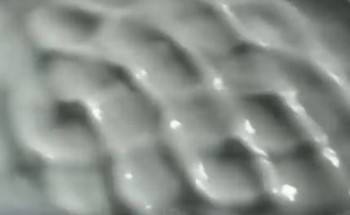
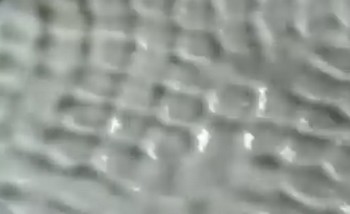
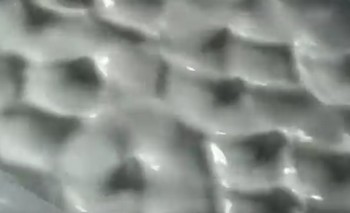
Note the similar gemoetric arrangment of "nodes" and the resulting bevel effect. The stills have been taken from this cymatics experiment on YouTube.
edit on 20-2-2017 by jeep3r because:
spelling
Fantastic thread and just for the record
the remote viewers from the Farsight experiment
both came up with infra sound energy as the method
of quarry.
*Warning if you don't believe sound could have been used
to quarry and move rock you certainly won't believe
2 remote viewers, in allegedly blind conditions,
came up with a similar idea.
youtu.be...
the remote viewers from the Farsight experiment
both came up with infra sound energy as the method
of quarry.
*Warning if you don't believe sound could have been used
to quarry and move rock you certainly won't believe
2 remote viewers, in allegedly blind conditions,
came up with a similar idea.
youtu.be...
originally posted by: UnderKingsPeak
Fantastic thread and just for the record
the remote viewers from the Farsight experiment
both came up with infra sound energy as the method
of quarry.
*Warning if you don't believe sound could have been used
to quarry and move rock you certainly won't believe
2 remote viewers, in allegedly blind conditions,
came up with a similar idea.
youtu.be...
I haven't got time to be watching youtube videos, what was the similar idea
It is certainly very interesting, however the db level it would take to do that in granite... how could anyone protect themselves from such energy?
no lost ´acoustic engineering technology´ ..may these patterns are just remnants of dolorite-pounding gangs, all in-sync, singing..so that they
kinda look in-sync in situ..
a reply to: Marduk
Just a general question to see how you explain this, Marduk--if dolerite pounders were used, and even though they are harder than the granite, they would still wear down and get reduced in size, why are all of the marks of seemingly equal size, showing no evidence of diminishing size as the pounders would have obviously chipped themselves away into smaller tools?
This is a serious question, even though it seems that I'm playing devil's advocate. I'm with the OP in sharing concern about the fit of the explanation of using the pounders to chip away an obelisk (just getting pounders into the underside of that unfinished obelisk with enough force to make much progress is an unanswered enigma with me).

And then you have areas like this--dolerite pounders? Really?
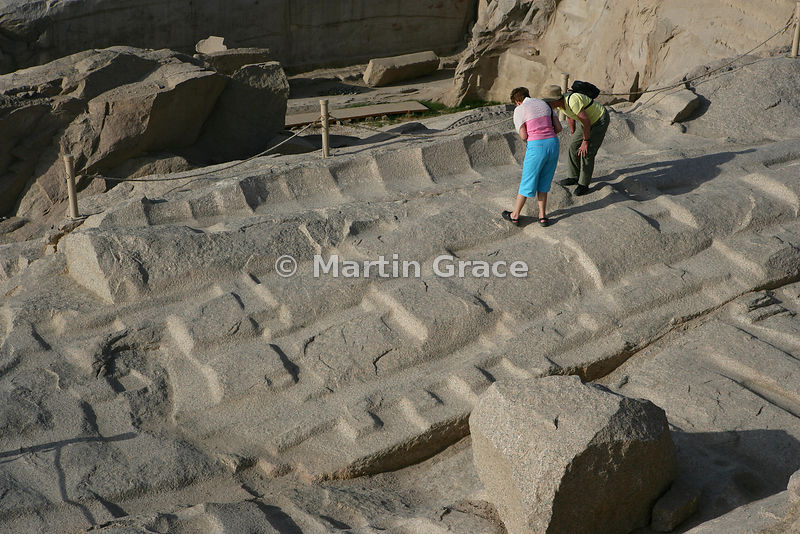
I'm not saying that this was done with sound waves, or magical stone-softening plant extracts, or power tools, or even accomplished by Merlin the Magician, but what I am saying is that I'm highly, HIGHLY skeptical of the official explanation--but that doesn't mean that I have to have the answer, either.
Just a general question to see how you explain this, Marduk--if dolerite pounders were used, and even though they are harder than the granite, they would still wear down and get reduced in size, why are all of the marks of seemingly equal size, showing no evidence of diminishing size as the pounders would have obviously chipped themselves away into smaller tools?
This is a serious question, even though it seems that I'm playing devil's advocate. I'm with the OP in sharing concern about the fit of the explanation of using the pounders to chip away an obelisk (just getting pounders into the underside of that unfinished obelisk with enough force to make much progress is an unanswered enigma with me).

And then you have areas like this--dolerite pounders? Really?

I'm not saying that this was done with sound waves, or magical stone-softening plant extracts, or power tools, or even accomplished by Merlin the Magician, but what I am saying is that I'm highly, HIGHLY skeptical of the official explanation--but that doesn't mean that I have to have the answer, either.
originally posted by: SlapMonkey
a reply to: Marduk
Just a general question to see how you explain this, Marduk--if dolerite pounders were used, and even though they are harder than the granite, they would still wear down and get reduced in size, why are all of the marks of seemingly equal size, showing no evidence of diminishing size as the pounders would have obviously chipped themselves away into smaller tools?
Maybe they used lots of pounders, yanno, like they actually found at the site on the floor next to the obelisk, did you read the woo page linked in the OP ?
also, the marks are not equal size
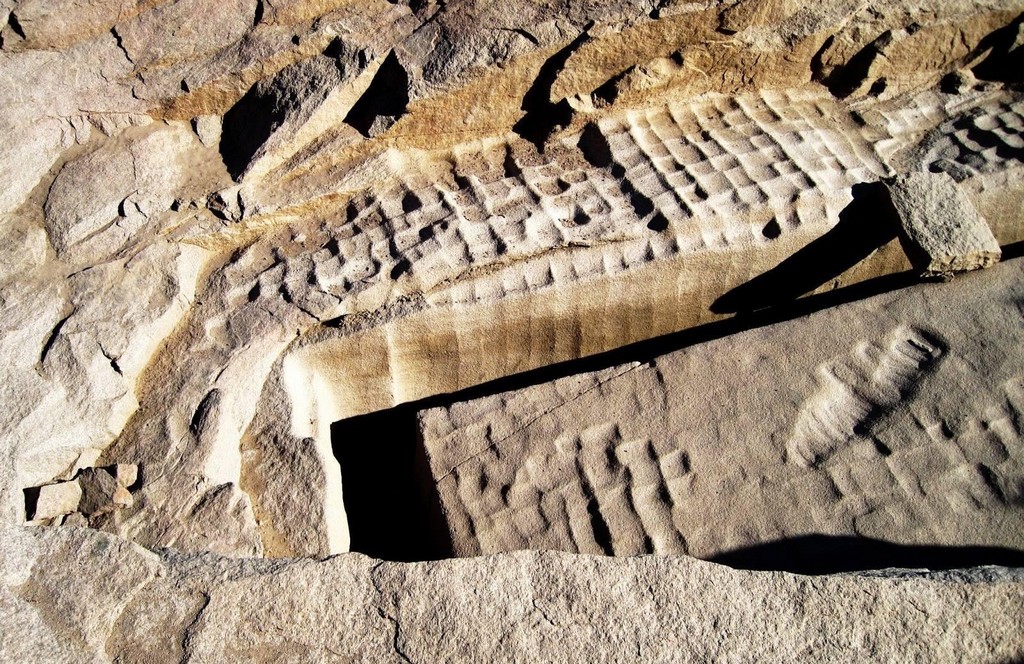
Nor do dolerite pounders chip and get reduced in size like that, its very hard
Dolerite is composed of Plagioclase and Pyroxene. As the result, it is three times as stiff as Granite. And it deflects only 1/3 rd as much as Granite, under an equal load. Dolerite is quite uniform in hardness. Its Scleroscope readings averaging >Hs 95. Density of Dolerite is more than offsets the 10% greater hardness of the few very hardest Granite. As the result Dolerite can provide greater wear resistance than compared with any sort of Granites . The Co-efficient of linear expansion hold by the Dolerite is 2.4 X10-6/ oC. Granite holds bits higher in this regard as 4.16 X 10 -6/ oC.
edit on 21-2-2017 by Marduk because: (no reason given)
a reply to: Marduk
That's all well and good (and I fully understand that it's quite a bit sturdier than granite), but my point still stands: All rocks, igneous or otherwise, chip and flake away when used in contact with another rock, especially one that's as hard as granite, even if the pounder is harder.
Here's the thing, though--a LOT of substance has been removed in those pictures, and the size of the pounder in what appear to be rows or columns tends to stay seemingly (a word I used before) the same size all the way down into the trench? Furthermore, with dolerite being as hard as it is, how did they shape the pounders to be of such seemingly equal size to each other?
If you want to buy into the dolerite-pounder hypothesis (again, we have no proof that this is how they actually dug out the rough-cut obelisks, just circumstantial evidence), then have at it. I just don't buy into it 100% like you do. I'm not saying that they may not have been used at some point during the excavation of the obelisks, but I really don't see that many cubic yards of granite being slowly chipped away by blunt dolerite instruments. But, hell, who knows, right?
That's all well and good (and I fully understand that it's quite a bit sturdier than granite), but my point still stands: All rocks, igneous or otherwise, chip and flake away when used in contact with another rock, especially one that's as hard as granite, even if the pounder is harder.
Here's the thing, though--a LOT of substance has been removed in those pictures, and the size of the pounder in what appear to be rows or columns tends to stay seemingly (a word I used before) the same size all the way down into the trench? Furthermore, with dolerite being as hard as it is, how did they shape the pounders to be of such seemingly equal size to each other?
If you want to buy into the dolerite-pounder hypothesis (again, we have no proof that this is how they actually dug out the rough-cut obelisks, just circumstantial evidence), then have at it. I just don't buy into it 100% like you do. I'm not saying that they may not have been used at some point during the excavation of the obelisks, but I really don't see that many cubic yards of granite being slowly chipped away by blunt dolerite instruments. But, hell, who knows, right?
edit on 21-2-2017 by SlapMonkey because: accidentally typed in "diorite" instead of "dolerite"...fixed it
originally posted by: SlapMonkey
If you want to buy into the dolerite-pounder hypothesis (again, we have no proof that this is how they actually dug out the rough-cut obelisks, just circumstantial evidence), then have at it. I just don't buy into it 100% like you do. I'm not saying that they may not have been used at some point during the excavation of the obelisks, but I really don't see that many cubic yards of granite being slowly chipped away by blunt dolerite instruments. But, hell, who knows, right?
I don't buy into everything that hard core Egyptologists state is the truth, for instance I don't believe that Khufu was totally the builder of the GP, but when you have evidence that a piece of rock has been pounded and the floor around it is littered with pounders and experimental archaeologists have replicated the method, well, its not rocket science is it. But when its a case of who knows, its always best to go with the evidence that's right in front of you..
But you're right about the dolerite, it does fracture, here's a picture of one from the Obelisk site, which appears to have fractured, almost as if someone was pounding something large and hard with it
www.martingracephotography.com...
Here's a description of the methods used to excavate the block
edit on 21-2-2017 by Marduk because: (no reason given)
originally posted by: SlapMonkey
Here's the thing, though--a LOT of substance has been removed in those pictures, and the size of the pounder in what appear to be rows or columns tends to stay seemingly (a word I used before) the same size all the way down into the trench? Furthermore, with dolerite being as hard as it is, how did they shape the pounders to be of such seemingly equal size to each other?
Stop for a minute and consider that the individual "scallops" aren't the same size as the pounders.
I mean, it's not a huge leap by any measure.
So, the workers bashed those scallops out with a pounder smaller than the scallop. They are close together because the workers were close together. They progress linearly forward because the workers progressed linearly forward with their bashing (or, more likely, backwards.)
You weren't thinking that somehow these scallops were the same size and shape as the pounders, were you?
Not really, I mean?
Harte
originally posted by: SlapMonkey
If you want to buy into the dolerite-pounder hypothesis (again, we have no proof that this is how they actually dug out the rough-cut obelisks, just circumstantial evidence), then have at it. I just don't buy into it 100% like you do. I'm not saying that they may not have been used at some point during the excavation of the obelisks, but I really don't see that many cubic yards of granite being slowly chipped away by blunt dolerite instruments. But, hell, who knows, right?
There's a theory I subscribe to that says the granite was pretreated with fire, which would crack the crystalline structure to a depth of an inch or two, making the granite much easier to crunch through with a pounder after the stone cooled.
You'd have to watch the fires closely, for sure, which could provide some partial explanation of how the unfinished one cracked. The main reason the crack formed (they say) is because the stone was free and previously existing stresses on it were released.
The same idea of using fire on granite might provide the method used to carve the exquisitely perfect hieroglyphics in the obelisks they were successful erecting.
I don't know if any of those glyph surfaces have been examined for evidence of fire. I'm not even sure such evidence could be definitively found.
But the idea fits very well with what we see and what you said about how hard granite is.
Harte
originally posted by: SlapMonkey
a reply to: Marduk
Just a general question to see how you explain this, Marduk--if dolerite pounders were used, and even though they are harder than the granite, they would still wear down and get reduced in size, why are all of the marks of seemingly equal size, showing no evidence of diminishing size as the pounders would have obviously chipped themselves away into smaller tools?
You haven't been to the quarries, I take it?
The pounders are there. They seemed to like a certain size and discarded used ones that were smaller. There's a LOT of them there.
They didn't pound things down to pebbles. They abandoned them when they no longer conveniently fit in two hands as a rule.
I'm not saying that this was done with sound waves, or magical stone-softening plant extracts, or power tools, or even accomplished by Merlin the Magician, but what I am saying is that I'm highly, HIGHLY skeptical of the official explanation--but that doesn't mean that I have to have the answer, either.
You might change your mind if you went on a tour to Egypt and saw it for yourself. The people who are saying that it's pounding stones are people who have gone to Egypt, looked at the marks, looked at the discarded tools, cataloged them (for years), surveyed them, analyzed them, marked where they were found, and announced the conclusions after learning about the culture and learning to read the hieroglyphs and noting the tomb paintings.
Alternatively, you can go to Egypt yourself, learn to read hieroglyphs (not impossible), familiarize yourself with the paintings that depict stonework and the dates, go to the quarries, help unearth the tools, help catalog them in the museum, talk with the guides... and that would be a better way of finding out the truth than looking at a photo and saying "I think...."
a reply to: Harte
Look, my comments are based in my own experience sculpting with different rocks (but mainly really soft ones, like alabaster), so I get the progression from a raw piece of rock to a finished, glass-smooth surface.
If these are to be believed as the first step in removing material (which it seems that this is the case...these were the tools used to remove rock and create the rough shape), the what you just described to me makes zero sense, both in process and in efficiency. When you look at the scallop shapes, they appear as though they are a cross section of a cylinder--as if you could lie a cylinder of the same circumference and length into the scallop and it would rest comfortably.
When roughing out a shape, there is zero need to be that relatively precise in what you are doing, and at the same time, there is zero need to create such scalloped shapes to begin with (unless the pounders were that size and shape, and that's just what you got).
I can see what you're saying--workers lined up in a grid alignment, all pounding away at the same amount of surface area, the borders of said areas butting up against each other. That part of it can make perfect sense--I just don't see the efficiency and need and, quite honestly, the desire to make such initial shaping of the stone so relatively uniform like this.
Now, you introduce using fire as a means to break down the structure of the granite in order for it to be more easily chipped away with the pounders--without extreme knowledge of the effects on granite by fire (and doing a little bit of research), it seems that prolonged exposure to temperatures above 1,200-degrees (F) are necessary to damage granite (read that as 'affect the structure') to the point of reducing its hardness. While that's not an impossible task by any means (at least on the surface...once underneath the structure, it really makes you wonder if this was done), it would seem that evidence of such a process would exist and be fairly readily noticeable.
This was something interesting that I came across, talking about the effects of a fire on granite walls. As you can see in the picture from that site, the damaged areas of the granite from the heat are noticeably different than the undamaged areas (starting at the archway and moving up and to the right):
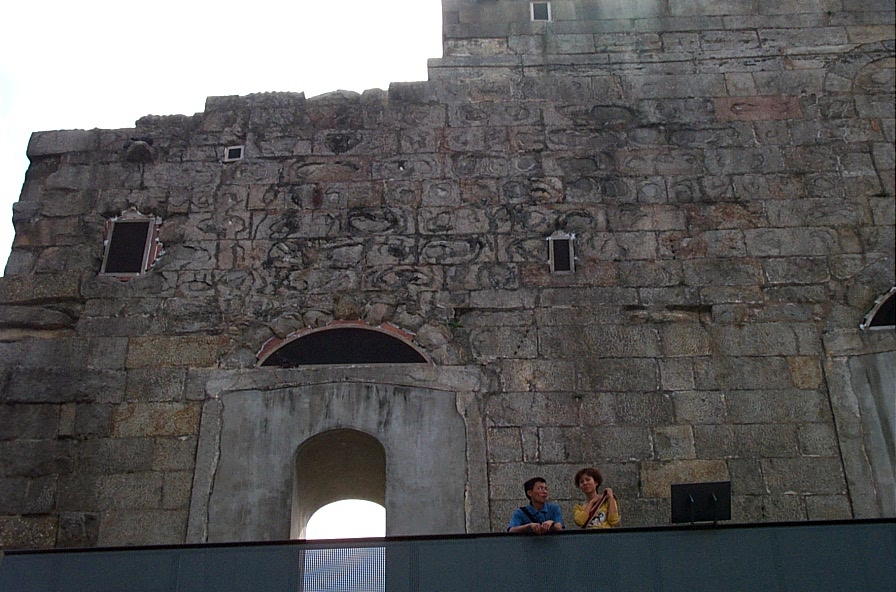
So, while a possibility, I'm still not convinced that such a process happened and has not been discovered or proven, yet.
Anyhoo, just my thoughts on the issue. Like I noted before, I'm not implying that it was aliens or that they had some magical granite-scooping technology, but I just don't buy into the pounder theory, even if I don't have an alternative to propose.
Look, my comments are based in my own experience sculpting with different rocks (but mainly really soft ones, like alabaster), so I get the progression from a raw piece of rock to a finished, glass-smooth surface.
If these are to be believed as the first step in removing material (which it seems that this is the case...these were the tools used to remove rock and create the rough shape), the what you just described to me makes zero sense, both in process and in efficiency. When you look at the scallop shapes, they appear as though they are a cross section of a cylinder--as if you could lie a cylinder of the same circumference and length into the scallop and it would rest comfortably.
When roughing out a shape, there is zero need to be that relatively precise in what you are doing, and at the same time, there is zero need to create such scalloped shapes to begin with (unless the pounders were that size and shape, and that's just what you got).
I can see what you're saying--workers lined up in a grid alignment, all pounding away at the same amount of surface area, the borders of said areas butting up against each other. That part of it can make perfect sense--I just don't see the efficiency and need and, quite honestly, the desire to make such initial shaping of the stone so relatively uniform like this.
Now, you introduce using fire as a means to break down the structure of the granite in order for it to be more easily chipped away with the pounders--without extreme knowledge of the effects on granite by fire (and doing a little bit of research), it seems that prolonged exposure to temperatures above 1,200-degrees (F) are necessary to damage granite (read that as 'affect the structure') to the point of reducing its hardness. While that's not an impossible task by any means (at least on the surface...once underneath the structure, it really makes you wonder if this was done), it would seem that evidence of such a process would exist and be fairly readily noticeable.
This was something interesting that I came across, talking about the effects of a fire on granite walls. As you can see in the picture from that site, the damaged areas of the granite from the heat are noticeably different than the undamaged areas (starting at the archway and moving up and to the right):

So, while a possibility, I'm still not convinced that such a process happened and has not been discovered or proven, yet.
Anyhoo, just my thoughts on the issue. Like I noted before, I'm not implying that it was aliens or that they had some magical granite-scooping technology, but I just don't buy into the pounder theory, even if I don't have an alternative to propose.
edit on 22-2-2017 by SlapMonkey because: (no reason given)
originally posted by: Byrd
You haven't been to the quarries, I take it?
The pounders are there. They seemed to like a certain size and discarded used ones that were smaller. There's a LOT of them there.
They didn't pound things down to pebbles. They abandoned them when they no longer conveniently fit in two hands as a rule.
No, I have not, and yes, I understand everything that you just said. It doesn't negate a single concern that I have.
I understand that nothing can replace being there in person, but for some of us, going to Egypt is cost-prohibitive and not necessarily high on the things-that-I-need-to-do-in-life check list. I would love to, and if you're willing to fund my travels over there, I'd go in a heartbeat, but since I can't, I'll continue to do the next best thing that fits my life and continue reading about and learning about ancient cultures like I have been doing since I was fascinated with "The Holy Lands" while bored in church as a child. I have been fascinated by what we know about ancient cultures around the world nearly my whole life, but I have been more fascinated by what we don't know--and I mean KNOW, not "theorize."
But, to your point about just saying "I think," thinking and employing critical thinking skills is a good thing, even if I can't go there and see things for myself. As I noted to Harte, much of where I draw my concerns with the pounder theory is from my own experience with sculpting stone. I just find it absolutely inefficient for the pounder theory to be the end-all as to how they started these massive removals of stone from the ground in granite quarries.
Like I have said multiple times in this thread, you're free to embrace the current accepted theory, but I hold out hope that they, after generations of building with stone, would have found a more efficient way to do the extraction--or, at the very least, rough shaping--of such massive chunks of granite.
But, in the same breath, I'm open to this being the factual way that it was done, but if it is, I pity those poor workers out in the Egyptian sun doing all of that pounding just so that the pharaoh could erect a massive phallus in the desert.
new topics
-
A Warning to America: 25 Ways the US is Being Destroyed
New World Order: 2 hours ago -
President BIDEN's FBI Raided Donald Trump's Florida Home for OBAMA-NORTH KOREA Documents.
Political Conspiracies: 8 hours ago -
Maestro Benedetto
Literature: 10 hours ago -
Is AI Better Than the Hollywood Elite?
Movies: 10 hours ago
top topics
-
President BIDEN's FBI Raided Donald Trump's Florida Home for OBAMA-NORTH KOREA Documents.
Political Conspiracies: 8 hours ago, 28 flags -
Gaza Terrorists Attack US Humanitarian Pier During Construction
Middle East Issues: 14 hours ago, 8 flags -
Massachusetts Drag Queen Leads Young Kids in Free Palestine Chant
Social Issues and Civil Unrest: 16 hours ago, 7 flags -
Las Vegas UFO Spotting Teen Traumatized by Demon Creature in Backyard
Aliens and UFOs: 13 hours ago, 6 flags -
A Warning to America: 25 Ways the US is Being Destroyed
New World Order: 2 hours ago, 6 flags -
Meadows, Giuliani Among 11 Indicted in Arizona in Latest 2020 Election Subversion Case
Mainstream News: 16 hours ago, 5 flags -
2024 Pigeon Forge Rod Run - On the Strip (Video made for you)
Automotive Discussion: 14 hours ago, 4 flags -
Is AI Better Than the Hollywood Elite?
Movies: 10 hours ago, 3 flags -
The functionality of boldening and italics is clunky and no post char limit warning?
ATS Freshman's Forum: 16 hours ago, 1 flags -
Maestro Benedetto
Literature: 10 hours ago, 1 flags
active topics
-
President BIDEN's FBI Raided Donald Trump's Florida Home for OBAMA-NORTH KOREA Documents.
Political Conspiracies • 19 • : ADVISOR -
When an Angel gets his or her wings
Religion, Faith, And Theology • 22 • : AcrobaticDreams1 -
King Charles 111 Diagnosed with Cancer
Mainstream News • 321 • : FlyersFan -
Is there a hole at the North Pole?
ATS Skunk Works • 41 • : burritocat -
Massachusetts Drag Queen Leads Young Kids in Free Palestine Chant
Social Issues and Civil Unrest • 16 • : FlyersFan -
Gaza Terrorists Attack US Humanitarian Pier During Construction
Middle East Issues • 33 • : FlyersFan -
Weinstein's conviction overturned
Mainstream News • 24 • : burritocat -
-@TH3WH17ERABB17- -Q- ---TIME TO SHOW THE WORLD--- -Part- --44--
Dissecting Disinformation • 690 • : burritocat -
University of Texas Instantly Shuts Down Anti Israel Protests
Education and Media • 266 • : SchrodingersRat -
New whistleblower Jason Sands speaks on Twitter Spaces last night.
Aliens and UFOs • 66 • : baablacksheep1
